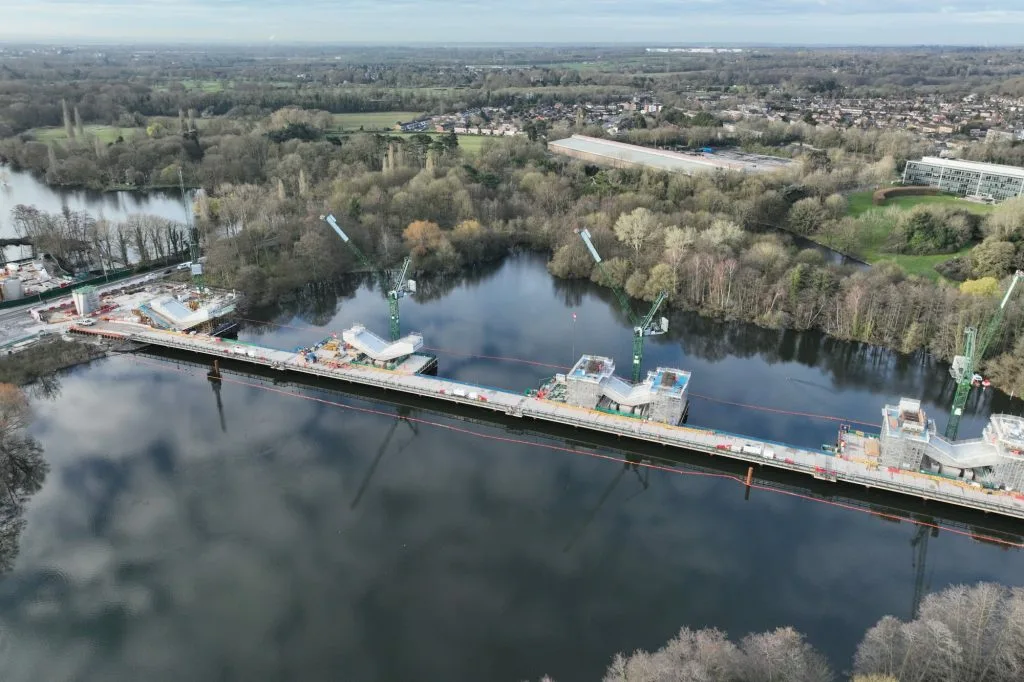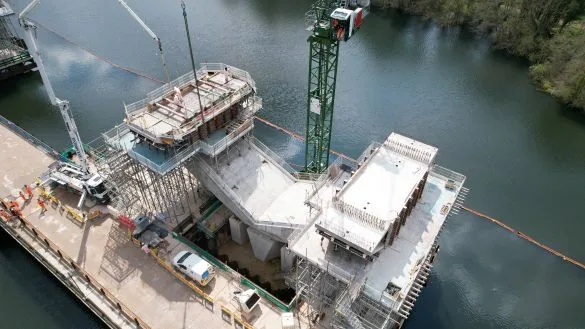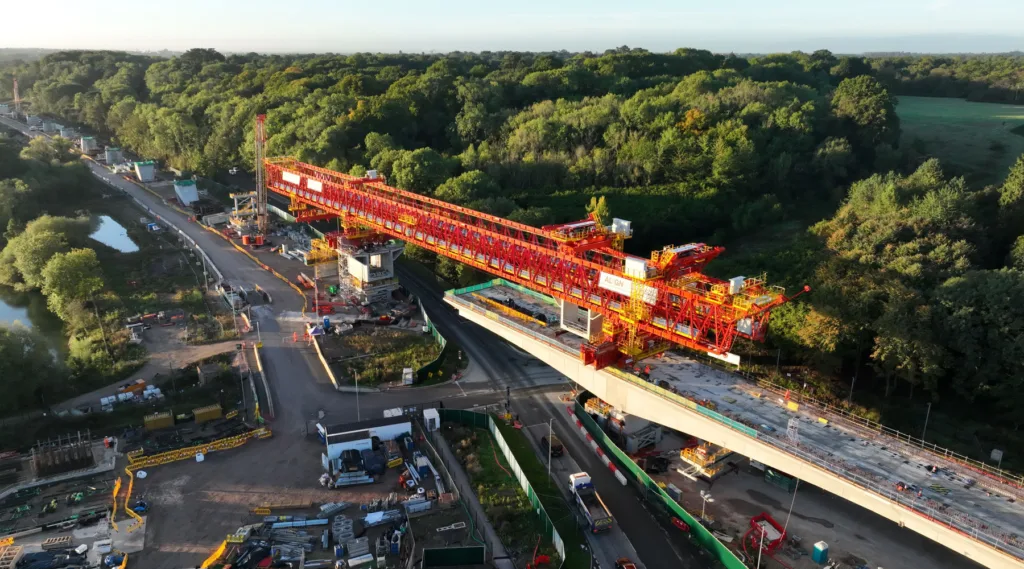Piers are vertical support structures that are placed under the viaduct, either on the ground or in the water. They provide secure passage of vehicles and trains over rivers, valleys, or roads situated below. The precise positioning of these piers is important for the movement of the elevated roadway or railways. As viaducts become more complex and span challenging terrains, there’s a greater emphasis on piers that offer enhanced structural integrity, adaptability, and aesthetics. In a significant stride forward, the construction and placement of giant lake piers for Colne Valley Viaduct, a part of the High Speed 2 (HS2) project, have been completed.
The viaduct, situated near Hillingdon, will span over two miles (3.4km) and will carry high-speed trains traversing the Grand Union Canal, River Colne, local roads, and a series of lakes, connecting London’s tunnels with the Chiltern tunnels.
About High-Speed 2 (HS2) project and importance of the viaduct for the project
The High-Speed 2 (HS2) project in the United Kingdom, designed to enhance the country’s rail network. The project aims to create a high-speed rail link between London, the Midlands, and the North, providing faster and more efficient connections between major cities and promoting economic growth.
Viaducts are a crucial part of the HS2 project, allowing the rail network to span obstacles such as rivers, highways, and urban areas. The viaduct is designed to provide a smooth and uninterrupted path for high-speed trains.
The huge viaduct project is being led by HS2’s main works contractor, Align JV – a team made up of Bouygues Travaux Publics, Sir Robert McAlpine, and Volker Fitzpatrick, working with key suppliers including VSL, Kilnbridge, Tarmac, and KVJV.

Advantages of a pier in viaduct construction and its importance for Colne Valley Viaduct
Piers are essential components of a viaduct, serving crucial roles in ensuring structural integrity, stability, and safety.
- Provides foundation support to the viaduct
- Supports the vertical loads of the viaduct including the weight of the bridge deck, vehicles, pedestrians, and other live loads.
- Provide the necessary elevation for the viaduct to clear obstacles such as roads, railways and water bodies
- Provides the necessary points for span attachment to keep the bridge deck stable over long distances.
Piers are essential to the Colne Valley Viaduct, as they will provide the structural support needed to carry the weight of the viaduct and the vehicles or trains crossing it. It will also provide the primary structural support for the viaduct spans carrying the high-speed railway tracks.
Completion of V-Shaped Piers
The first large V-shaped piers have been finished in the lake to facilitate the viaduct’s eastwood curve over the water. Each of these ‘V piers’ weighs a substantial 1,800 tonnes and will provide support for a series of graceful arches inspired by the motion of a stone skipping on water.
To accommodate the gentle curve of the viaduct, all one thousand segments that make up the arches and deck are uniquely shaped. These segments are manufactured at a temporary factory with direct access to the M25.

The construction of these piers involved casting them in place using large molds. Each pier, equipped with a separate tower crane, is linked to the main construction site through a temporary access bridge. Cofferdams were employed to prevent water ingress during the creation of the foundations, which were built 60 meters deep into the lakebed.
The Align Joint Venture (JV) successfully installed 292 concrete piles for the bridge’s foundations by January of this year. The project’s foundation, pier, and deck construction have been carried out concurrently by separate teams, progressing from north to south.
HS2 Ltd Project Client David Emms states, “The Colne Valley Viaduct will form a key part of the HS2 route – helping to deliver better connections across the UK, free up rail capacity on the existing network, and offer passengers zero carbon travel options. That’s why it’s great to see so much progress over the last 12 months and especially the completion of the piers that will allow the girder to head out over the lakes later this year.”
Role of the Launching Girder For Placing Concrete Segments on piers

The unique ‘launching girder,’ known as “Dominique,” played a pivotal role in segment assembly and placing concrete segments upon the piers.This 160-meter-long machine has placed over 300 segments out of the required 1,000 in the past year, showcasing its efficiency in viaduct construction. Once each section is complete, the machine inches itself forward to build the next stage.
Originally built in 2004, the launching girder was first used during the construction of the Hong Kong East Tsing Yi Viaduct. Specially designed to handle complex viaduct construction, the machine is named ‘Dominique’ in memory of Bouygues engineer Dominique Droniou who played a leading role in its design and development.
Align Project Director, Daniel Altier commented: “I am delighted that by working as an integrated team with our supply chain partners, we have been able to erect nearly a third of the deck and complete the first V pier, just a year since Dominique started operating”. He further stated ‘what has been achieved would not have been possible without the support of the different teams across the project including; Quality, Lifting, Safety, Consents, Environment, Surveying and also Earthworks, for maintaining the haul road on which the 60 -140 tonne segments are transported from our factory to meet the girder.”
The Way Forward
A total of 11 ‘v-piers’ will support the viaduct over water, with an additional 45 piers on land. The completion of the first pier sets the stage for the assembly of deck segments and the overall advancement of this significant viaduct project.
Alternating deck segments will now be positioned, utilising a cantilever technique to balance the structure as two half-arches are constructed simultaneously. Steel tensioning cables will subsequently be threaded through the segments to reinforce the bridge’s strength.
References;
mediacentre.hs2.org.uk,geplus.co.uk,https://www.constructionenquirer.com, hillingdontimes.co.uk, buckinghamshirelive.com, srm.com/news, alsina.com/in

